1. Pedersen AB, Mehnert F, Overgaard S, Johnsen SP. Allogeneic blood transfusion and prognosis following total hip replacement: a population-based follow up study. BMC Musculoskelet Disord. 2009; 10(1):167. PMID:
20040083.

2. Smeets SJ, Verbruggen JP, Poeze M. Effect of blood transfusion on survival after hip fracture surgery. Eur J Orthop Surg Traumatol. 2018; 28(7):1297–1303. PMID:
29752534.

3. Verlicchi F, Desalvo F, Zanotti G, Morotti L, Tomasini I. Red cell transfusion in orthopaedic surgery: a benchmark study performed combining data from different data sources. Blood Transfus. 2011; 9(4):383–387. PMID:
21627924.
4. Engoren M, Mitchell E, Perring P, Sferra J. The effect of erythrocyte blood transfusions on survival after surgery for hip fracture. J Trauma. 2008; 65(6):1411–1415. PMID:
19077635.

5. Spahn DR. Anemia and patient blood management in hip and knee surgery: a systematic review of the literature. Anesthesiology. 2010; 113(2):482–495. PMID:
20613475.
6. Eisenstaedt R, Penninx BW, Woodman RC. Anemia in the elderly: current understanding and emerging concepts. Blood Rev. 2006; 20(4):213–226. PMID:
16472893.

7. Arshi A, Lai WC, Iglesias BC, McPherson EJ, Zeegen EN, Stavrakis AI, et al. Blood transfusion rates and predictors following geriatric hip fracture surgery. Hip Int. 2021; 31(2):272–279. PMID:
31912747.

8. Partridge J, Harari D, Gossage J, Dhesi J. Anaemia in the older surgical patient: a review of prevalence, causes, implications and management. J R Soc Med. 2013; 106(7):269–277. PMID:
23759887.

9. Smith GH, Tsang J, Molyneux SG, White TO. The hidden blood loss after hip fracture. Injury. 2011; 42(2):133–135. PMID:
20236640.

10. Koval KJ, Rosenberg AD, Zuckerman JD, Aharonoff GB, Skovron ML, Bernstein RL, et al. Does blood transfusion increase the risk of infection after hip fracture? J Orthop Trauma. 1997; 11(4):260–265. PMID:
9258823.

11. Shin HJ, Kim JH, Han SB, Park JH, Jang WY. Allogeneic red blood cell transfusion is an independent risk factor for 1-year mortality in elderly patients undergoing femoral neck fracture surgery: retrospective study. Medicine (Baltimore). 2020; 99(35):e21897. PMID:
32871921.
12. Guo Y, Jia P, Zhang J, Wang X, Jiang H, Jiang W. Prevalence and risk factors of postoperative delirium in elderly hip fracture patients. J Int Med Res. 2016; 44(2):317–327. PMID:
26920926.

13. Gani F, Cerullo M, Ejaz A, Gupta PB, Demario VM, Johnston FM, et al. Implementation of a blood management program at a tertiary care hospital: effect on transfusion practices and clinical outcomes among patients undergoing surgery. Ann Surg. 2019; 269(6):1073–1079. PMID:
31082904.

14. Rineau E, Chaudet A, Chassier C, Bizot P, Lasocki S. Implementing a blood management protocol during the entire perioperative period allows a reduction in transfusion rate in major orthopedic surgery: a before-after study. Transfusion. 2016; 56(3):673–681. PMID:
26748489.

15. Shin HJ, Kim JH, Park Y, Ahn KH, Jung JS, Park JH, et al. Effect of patient blood management system and feedback programme on appropriateness of transfusion: an experience of Asia’s first Bloodless Medicine Center on a hospital basis. Transfus Med. 2021; 31(1):55–62. PMID:
33368693.

16. Jang SY, Cha YH, Yoo JI, Oh T, Kim JT, Park CH, et al. Blood transfusion for elderly patients with hip fracture: a nationwide cohort study. J Korean Med Sci. 2020; 35(37):e313. PMID:
32959543.

17. Suh YS, Lee JJ, Nho JH, Lee JJ, Won SH, Yang HJ. Transfusion trends in hip arthroplasty in Korea: a nationwide study by the Korean National Health Insurance Service. Transfusion. 2019; 59(7):2324–2333. PMID:
31022315.

18. Putot A, Zeller M, Perrin S, Beer JC, Ravisy J, Guenancia C, et al. Blood transfusion in elderly patients with acute myocardial infarction: data from the RICO survey. Am J Med. 2018; 131(4):422–429.e4. PMID:
29030059.

19. Amin RM, DeMario VM, Best MJ, Shafiq B, Hasenboehler EA, Sterling RS, et al. A restrictive hemoglobin transfusion threshold of less than 7 g/dL decreases blood utilization without compromising outcomes in patients with hip fractures. J Am Acad Orthop Surg. 2019; 27(23):887–894. PMID:
30829898.

20. Goodnough LT, Maggio P, Hadhazy E, Shieh L, Hernandez-Boussard T, Khari P, et al. Restrictive blood transfusion practices are associated with improved patient outcomes. Transfusion. 2014; 54(10 Pt 2):2753–2759. PMID:
24995770.

21. Carson JL, Terrin ML, Noveck H, Sanders DW, Chaitman BR, Rhoads GG, et al. Liberal or restrictive transfusion in high-risk patients after hip surgery. N Engl J Med. 2011; 365(26):2453–2462. PMID:
22168590.

22. Parker MJ. Randomised trial of blood transfusion versus a restrictive transfusion policy after hip fracture surgery. Injury. 2013; 44(12):1916–1918. PMID:
23756263.

23. Gregersen M, Borris LC, Damsgaard EM. Blood transfusion and overall quality of life after hip fracture in frail elderly patients--the transfusion requirements in frail elderly randomized controlled trial. J Am Med Dir Assoc. 2015; 16(9):762–766. PMID:
25933728.

24. Shander A, Goobie SM, Warner MA, Aapro M, Bisbe E, Perez-Calatayud AA, et al. Essential role of patient blood management in a pandemic: a call for action. Anesth Analg. 2020; 131(1):74–85. PMID:
32243296.

25. Cho SH. Need for patient blood management to prepare for an unstable blood supply crisis. Korean J Blood Transfus. 2021; 32(3):217–220.

26. Korea Centers for Disease Control and Prevention. Guidelines for Blood Transfusion. 4th ed. Cheongju, Korea: Korea Centers for Disease Control and Prevention;2016.
27. Carson JL, Guyatt G, Heddle NM, Grossman BJ, Cohn CS, Fung MK, et al. Clinical practice guidelines from the AABB: red blood cell transfusion thresholds and storage. JAMA. 2016; 316(19):2025–2035. PMID:
27732721.
28. Soumerai SB, Salem-Schatz S, Avorn J, Casteris CS, Ross-Degnan D, Popovsky MA. A controlled trial of educational outreach to improve blood transfusion practice. JAMA. 1993; 270(8):961–966. PMID:
8123097.

29. Salem-Schatz SR, Avorn J, Soumerai SB. Influence of clinical knowledge, organizational context, and practice style on transfusion decision making. Implications for practice change strategies. JAMA. 1990; 264(4):476–483. PMID:
2366281.

30. Liumbruno GM, Rafanelli D. Appropriateness of blood transfusion and physicians’ education: a continuous challenge for hospital transfusion committees? Blood Transfus. 2012; 10(1):1–3. PMID:
22044957.
31. Haynes SL, Torella F. The role of hospital transfusion committees in blood product conservation. Transfus Med Rev. 2004; 18(2):93–104. PMID:
15067589.

32. Di Bartolomeo E, Merolle L, Marraccini C, Canovi L, Berni P, Guberti M, et al. Patient blood management: transfusion appropriateness in the post-operative period. Blood Transfus. 2019; 17(6):459–464. PMID:
31403929.
33. Merolle L, Marraccini C, Di Bartolomeo E, Montella MT, Pertinhez TA, Baricchi R, et al. Postoperative patient blood management: transfusion appropriateness in cancer patients. Blood Transfus. 2020; 18(5):359–365. PMID:
32931414.
34. Joy PJ, Bennet SJ. The appropriateness of blood transfusion following primary total hip replacement. Ann R Coll Surg Engl. 2012; 94(3):201–203. PMID:
22507728.

35. Park JW, Won SH, Moon SY, Lee YK, Ha YC, Koo KH. Burden and future projection of revision Total hip Arthroplasty in South Korea. BMC Musculoskelet Disord. 2021; 22(1):375. PMID:
33888097.

36. Gupta PB, DeMario VM, Amin RM, Gehrie EA, Goel R, Lee KH, et al. Patient blood management program improves blood use and clinical outcomes in orthopedic surgery. Anesthesiology. 2018; 129(6):1082–1091. PMID:
30124488.

37. Desai N, Schofield N, Richards T. Perioperative patient blood management to improve outcomes. Anesth Analg. 2018; 127(5):1211–1220. PMID:
29064875.

38. Yang WW, Thakkar RN, Gehrie EA, Chen W, Frank SM. Single-unit transfusions and hemoglobin trigger: relative impact on red cell utilization. Transfusion. 2017; 57(5):1163–1170. PMID:
28164305.

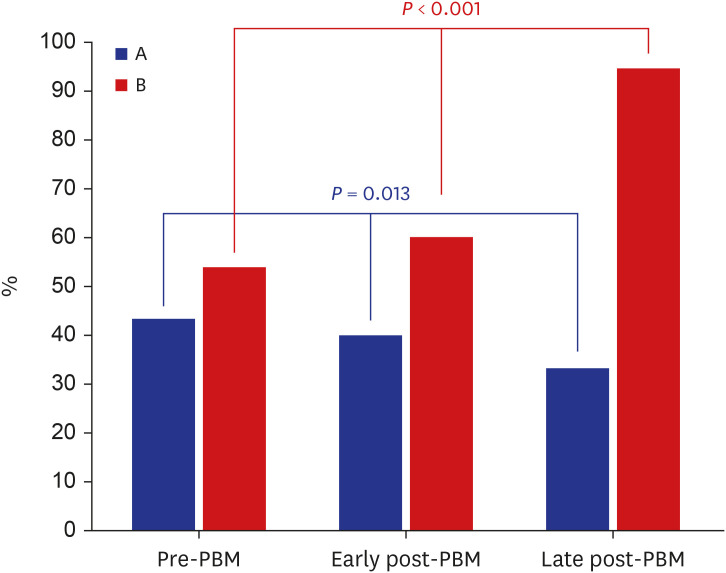
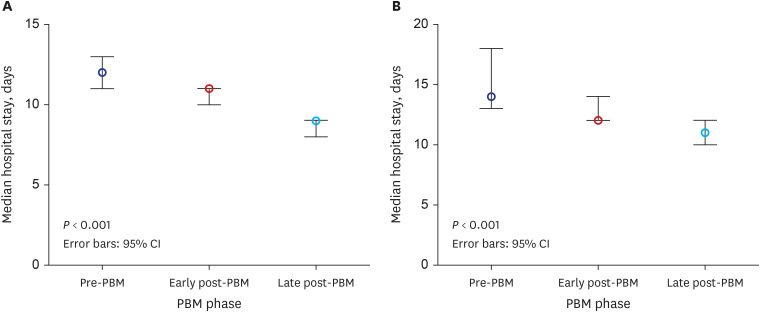
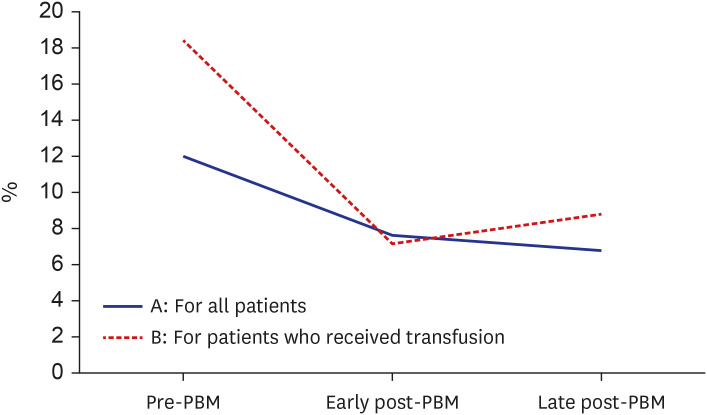
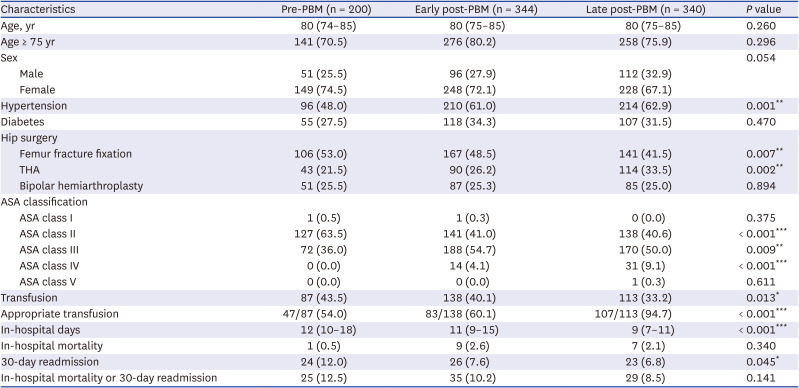
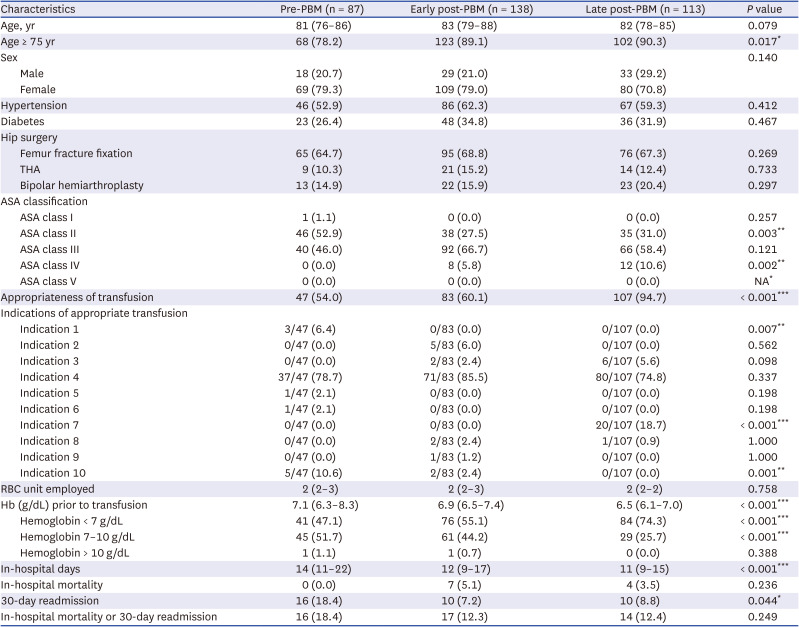
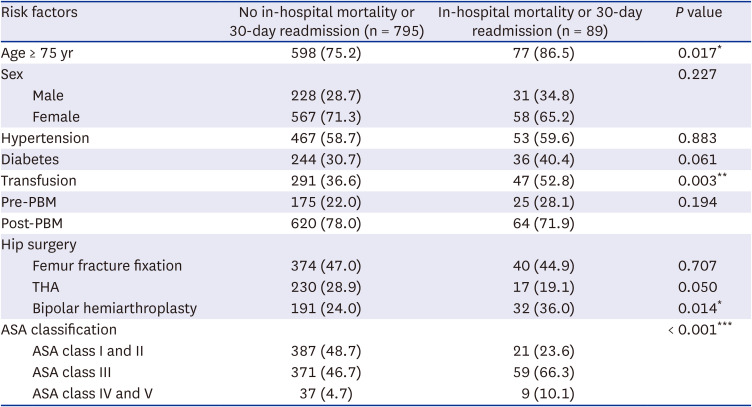
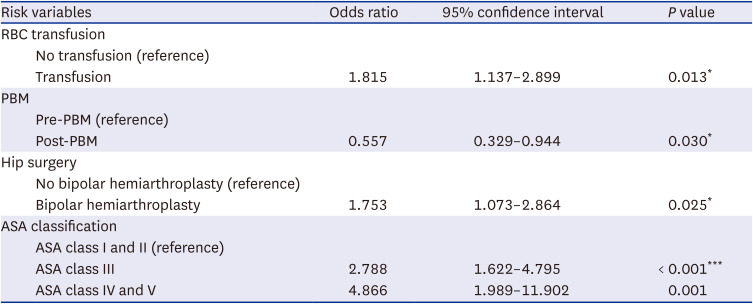




 PDF
PDF Citation
Citation Print
Print



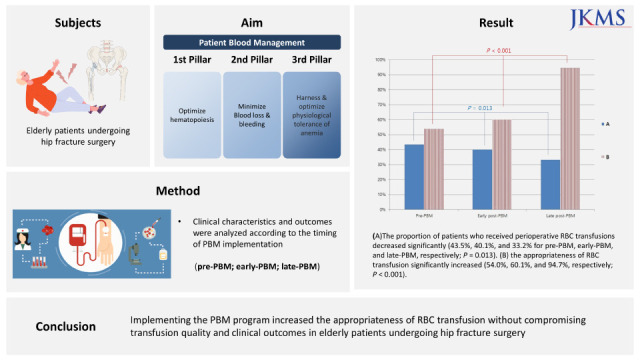
 XML Download
XML Download